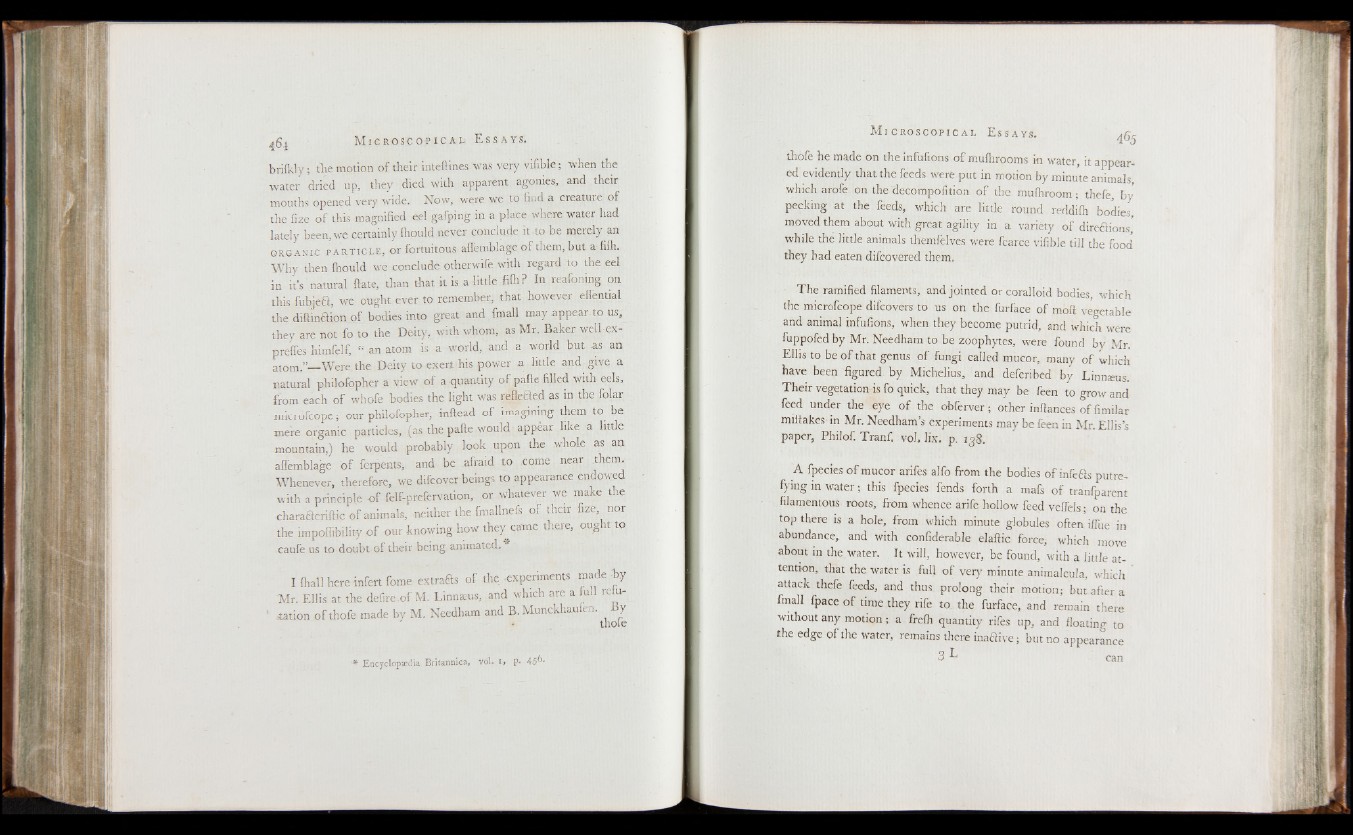
brifkly; the motion o f their inteftines was very vifible; when the
water dried up, they died with apparent agonies, and their
mouths opened very wide. Now, were we to find a creature of
the fize of this magnified eel gafping in a place where water had
lately been, we certainly fhould never conclude it to be merely an
O R G A N IC P A R T I C L E , or fortuitous affemblage of them, but a filh.
Why then fhould we conclude otherwife with regard to the eel
in it’s natural ftate, than that it is a little fifli? In reafoning on
this fubjeft, we ought ever to remember, that however eflential
the diftinftion of bodies into great and fmall may appear to us,
they are not fo to the Deity, with whom, as Mr. Baker well ex-
prefles himfelf, ■ an atom is a world, and a world but as an
atom.”— Were the Deity to exert his power a little and give a
natural philofopher a view o f a quantity o f pafte filled with eels,
from each of whofe bodies the light was refleaed as in the folar
microfcope; our philofopher, inftead of imagining them to be
mere organic particles, (as the pafte would appear like a little
mountain,) he would probably look upon the whole as an
affemblage o f ferpents, and be afraid to come near them.
Whenever, therefore, we difcover beings to appearance endowed
with a principle -of felf-prefervation, or whatever we make the
charaaeriftic of animals, neither the fmallnefs o f their fize, nor
the impoflibility o f our knowing how they came there, ought to
caufe us to doubt of their being animated. - I
I {hall here infert fome extrafts of the experiments made b y
Mr. Ellis at the defire .of M. Linnaeus, and which are a full relu-
' .Nation o f thofe made by M. Needham and B. Munckhaufen. By
• thole
* Encyclopaedia Britannica, vol. 1, p. 45®.
thofe he made on the infufions of mufhrooms in water, it appeared
evidently that the feeds were put in motion by minute animals,
which arofe on the decompofition o f the mufhroom ; thefe, by
pecking at the feeds, which are little round reddifh bodies,
moved them about with great agility in a variety o f direaions,,
while the little animals themfelves were fcarce vifible till the food
they had eaten difcovered them.
The ramified filaments, and jointed or coralloid bodies, which
the microfcope difcovers to us on the furface o f moft vegetable
and animal infufions, when they become putrid, and which were
fuppofed by Mr. Needham to be zoophytes, were found by Mr.
Ellis to be o f that genus o f fungi called mucor, many o f which
have been figured by Michelius, and defcribed by Linnams.
Their vegetation is fo quick, that they may be feen to grow and
feed under the eye o f the obferver; other inftances of fimilar
miftakes' in Mr. Needham’s experiments may be feen in Mr. Ellis’s
paper, Philof. Tranf. vol. lix. p. 138.
A fpecies o f mucor arifes alfo from the bodies o f infefls putrefying
m water; this fpecies fends forth a mafs o f tranfparent
filamentous roots, from whence arife hollow feed veffels; on the
top there is a hole, from which minute globules often iffue in
abundance, and with confiderable elaftic force, which move
about in the water. It will, however, be found, with a little attention,
that the water is full o f very' minute animalcula, which
attack thefe feeds, and thus prolong their motion; but after a
fmall lpace o f time they rife to the furface, and remain there
without any motion; a frefh quantity rifes up, and floating to
the edge o f the water, remains there inafiive; but no appearance
can